Numerical Modeling of Groundwater Pollution by Chlorpyrifos, Bromacil and Terbuthylazine. Application to the Buñol-Cheste Aquifer (Spain)
Abstract
:1. Introduction
2. Materials and Methods
2.1. Available Tools for the Numerical Modeling of Pesticide Transport in Soil and Groundwater
- (i).
- Data related to climate, soil, hydrology and crop phenology characteristics at local or regional scale.
- (ii).
- Data related to the geometric dimensions and physicochemical characteristics of groundwater bodies.
- (iii).
- Data related to the physicochemical parameters of the pesticides to be evaluated (e.g., vapor pressure, solubility in water and molecular weight).
- (iv).
- Data related to the contaminant fate and transport characteristics (e.g., photolysis, half-life of the pesticide in the soil, foliar degradation and hydrolysis). The model allows selection of the pesticide application date and the corresponding mass applied to the cultivation fields.
- (v).
- PRZM5 output data are shareable in regulatory terms by USEPA as daily, mean and maximum pesticide concentration.
- (vi).
- Output data of pesticide concentrations in short and long simulation periods.
2.2. The Pesticide Root Zone Model (PRZM5)
- Crop Growth
- Irrigation
- Precipitation and Snowmelt
- Runoff
- Canopy Water Interception
- Evaporation
- Leaching
- Erosion
- Soil Temperature
- Chemical Application and Foliar Washoff
- Chemical Runoff and Vertical Transport in Soil
- Chemical Volatilization
3. Case Study. The Buñol-Cheste Aquifer in Valencia Region (Spain)
3.1. Description of the Study Area. Hydrogeological Context
3.2. Available Pesticide Observations from the Monitoring Network
3.3. Data Sources
- (i).
- Records of the Valencia Water Regional Authority (JRB);
- (ii).
- JRB’s Automatic Hydrographic Information System (SAIH);
- (iii).
- The Spanish National Meteorological Agency (AEMET);
- (iv).
- The Atlas of Solar Radiation in Spain using climate data from Satellite Application Facilities (SAF EUMETSAT);
- (v).
- Data and cartography provided by JRB.
4. Results
4.1. Chlorpyrifos Simulations
4.2. Bromacil Simulations
4.3. Terbuthylazine Simulations
5. Discussion
6. Conclusions
- (i).
- a set of databases, according to the parameters required by an unsaturated contaminant transport model;
- (ii).
- a sensitivity analysis of the model parameters, including the pesticide annual application dose (kg/ha);
- (iii).
- estimation of the annual concentration values of every pesticide under a risk assessment framework for the first time in the Buñol-Cheste aquifer.
Author Contributions
Funding
Institutional Review Board Statement
Informed Consent Statement
Data Availability Statement
Conflicts of Interest
References
- EPA. EPA Guidelines for Responsible Pesticide Use; EPA: Adelaide, Australia, 2005; ISBN 1921125055.
- Azevedo, A.S.O.N. Assessment and Simulation of Atrazine as Influenced by Drainage and Irrigation. An Interface between RZWQM and ArcView GIS. Ph.D. Thesis, Iowa State University, Ames, IA, USA, 1998. [Google Scholar]
- Arias-Estévez, M.; López-Periago, E.; Martínez-Carballo, E.; Simal-Gándara, J.; Mejuto, J.C.; García Río, L. The mobility and degradation of pesticides in soils and the pollution of groundwater resources. Agric. Ecosyst. Environ. 2008, 123, 247–260. [Google Scholar] [CrossRef]
- CHJ. Plan Hidrológico de la Demarcación Hidrográfica del Júcar, Memoria, Ciclo de Planificación Hidrológica 2015–2021; Confederación Hidrográfica del Júcar, Ministerio de Agricultura, Alimentación y Medio Ambiente: Valencia, Spain, 2015.
- CHJ. Estudios de Caracterización y Modelación de Procesos de Contaminación por Pesticidas en la Demarcación Hidrográfica del Júcar; CHJ: Valencia, Spain, 2018. [Google Scholar]
- Belenguer, V.; Martínez Capel, F.; Masiá, A.; Picó, Y. Patterns of presence and concentration of pesticides in fish and waters of the Júcar River (Eastern Spain). J. Hazard. Mater. 2014, 265, 271–279. [Google Scholar] [CrossRef] [Green Version]
- Ccanccapa, A.; Masiá, A.; Andreu, V.; Picó, Y. Spatio-temporal patterns of pesticide residues in the Turia and Júcar Rivers (Spain). Sci. Total Environ. 2016, 540, 200–210. [Google Scholar] [CrossRef]
- Masiá, A.; Camo, J.; Vázquez-Roig, P.; Blasco, C.; Picó, Y. Screening of currently used pesticides in water, sediments and biotaof the Guadalquivir River Basin (Spain). J. Hazard. Mater. 2013, 263, 95–104. [Google Scholar] [CrossRef] [PubMed]
- Fernández, F.; Marín, J.M.; Pozo, O.J.; Sancho, J.V.; Lòpez, F.J.; Morell, I. Pesticide residues and transformation products in groundwater from a Spanish agricultural region on the Mediterranean Coast. Int. J. Environ. Anal. Chem. 2008, 88, 409–424. [Google Scholar] [CrossRef]
- Menchen, A.; De Las Heras, J.; Gómez Alday, J.J. Pesticide contamination in groundwater bodies in the Júcar River European Union Pilot Basin (SE Spain). Environ. Monit. Assess. 2017, 189. [Google Scholar] [CrossRef]
- Cabeza, Y.; Candela, L.; Ronen, D.; Teijon, D. Monitoring the occurrence of emerging contaminants in treated wastewater and groundwater between 2008 and 2010. The Baix Llobregat (Barcelona, Spain). J. Hazard. Mater. 2012, 239–240, 32–39. [Google Scholar] [CrossRef]
- Leonard, R.A. Movement of pesticides into surface waters. In Pesticides in the Soil Environment: Processes, Impacts, and Modeling; Cheng, H.H., Ed.; Wiley Online Library: Madison, WI, USA, 1990; pp. 303–349. [Google Scholar]
- Ravi, V.; Johnson, J.A. PESTAN: Pesticide Analytical Model Version 4.0 User’s Guide; U.S Environmental Protection Agency (EPA): Washington, DC, USA, 1992.
- Cheng, Y.; Zhou, J.-Y.; Shan, Z.-J.; Kong, D. SCI-GROW Model for Groundwater Risk Assessment of Pesticides. J. Ecol. Rural. Environ. 2007, 23, 78–82. [Google Scholar]
- Voss, C.I.; Provost, A.M. A Model for Saturated-Unsaturated Variable-Density Ground-Water Flow with Solute or Energy Transport; (Water-Resources Investigations Report 02-4231); U.S. Geological Survey: Reston, VA, USA, 2002.
- Šimůnek, J.; Genuchten, M.; Šejna, M. The HYDRUS Software Package for Simulating the Two- and Three-Dimensional Movement of Water, Heat, and Multiple Solutes in Variably-Saturated Porous Media; PC-Progress: Prague, Czech Republic, 2018. [Google Scholar]
- Beltman, W.H.J.; Ter Horst, M.M.S.; Adriaanse, P.I.; De Jong, A. Manual of FOCUS_TOXSWA Version 2.2.1; Alterra-Rapport 586; Alterra: Wageningen, The Netherlands, 2006; 198p. [Google Scholar]
- Van den Berg, E.; Tiktak, A.; Boesten, J.; Van der Linden, T. PEARL Model for Pesticide Behaviour and Emissions in Soil-Plant Systems; Statutory Research Tasks Unit for Nature & the Environment: Wageningen, The Netherlands, 2016. [Google Scholar]
- Boesten, J.J.T.I.; Gottesbüren, B. Testing PESTLA by two modellers for bentazone and ethoprophos in a sand soil. Agric. Water Manag. 2000, 44, 283–305. [Google Scholar] [CrossRef]
- Scorza Júnior, R.P.; Boesten, J.J.T.I. Simulation of pesticide leaching in a cracking clay soil with the PEARL model. Pest Manag. Sci. 2005, 61, 432–448. [Google Scholar] [CrossRef]
- Di, H.J.; Anylmore, L.A.G. Modeling the Probabilities of Groundwater Contamination by Pesticides. Soil Sci. Soc. Am. J. 1997, 61, 17–23. [Google Scholar] [CrossRef]
- Teklu, B.M.; Adriaanse, P.I.; Ter Horst, M.M.; Deneer, J.W.; Van den Brink, P.J. Surface water risk assessment of pesticide in Ethiopia. Sci. Total Environ. 2015, 508, 566–574. [Google Scholar] [CrossRef]
- Huff Hartz, K.E.; Edwards, T.M.; Lydy, M.J. Fate and transport of furrow-applied granular tefluthrin and seedcoated clothianidin insecticides: Comparison of field-scale observations and model estimates. Ecotoxicology 2017, 26, 876–888. [Google Scholar] [CrossRef]
- D’Andrea, M.F.; Letourneau, G.; Rousseau, A.N.; Brodeur, J.C. Sensitivity analysis of the Pesticide in Water Calculator model for applications in the Pampa region of Argentina. Sci. Total Environ. 2020, 698, 134232. [Google Scholar] [CrossRef]
- Chen, H.; Zhang, X.; Demars, C.; Zhang, M. Numerical simulation of agricultural sediment and pesticide runoff: RZWQM and PRZM comparison. Hydrol. Process. 2017, 31, 2464–2476. [Google Scholar] [CrossRef]
- Young, D.F.; Fry, M.M. PRZM5 A Model for Predicting Pesticides in Runoff, Erosion, and Leachate Revision B; Office of Pesticide Programs, U.S. Environmental Protection Agency: Washington, DC, USA, 2020.
- Young, D.F. Pesticide in Water Calculator User Manual for Versions 1.50 and 1.52; U.S. Environmental Protection Agency: Washington, DC, USA, 2016.
- Young, D.F. U.S. Environmental Protection Agency Model for Estimating Pesticides in Surface Water. In Pesticides in Surface Water: Monitoring, Modeling, Risk Assessment, and Management; Goh, K.S., Gan, J., Young, D.F., Luo, Y., Eds.; Oxford University Press: Oxford, UK, 2020; pp. 309–331. [Google Scholar]
- Rodrigo-Ilarri, J.; Rodrigo-Clavero, M.-E.; Cassiraga, E.; Ballesteros-Almonacid, L. Assessment of Groundwater, contamination by Terbuthylazine using vadose zone numerical models. Case Study of Valencia Province (Spain). Int. J. Environ. Res. Public Health 2020, 17, 3280. [Google Scholar] [CrossRef]
- Loague, K.; Lloyd, D.; Nguyen, A.; Davis, S.N.; Abrams, R.H. A case study simulation of DBCP groundwater contamination in Fresno County, California 1. Leaching through the unsaturated subsurface. J. Contam. Hydrol. 1998, 29, 109–136. [Google Scholar] [CrossRef]
- Trevisan, M.; Errera, G.; Goerlitz, G.; Remy, B.; Sweeney, P. Modelling ethoprophos and bentazone fate in a sandy humic soil with primary pesticide fate model PRZM-2. Agric. Water Manag. 2000, 44, 317–335. [Google Scholar] [CrossRef]
- Ma, Q.; Hook, J.E.; Wauchope, R.D.; Dowler, C.C.; Jhonson, A.W.; Davis, J.G.; Gascho, G.J.; Truman, C.C.; Sumner, H.R.; Chandler, L.D. GLEAMS, Opus, PRZM2β, and PRZM3 Simulations Compared with Measured Atrazine Runoff. Soil Sci. Soc. Am. J. 2000, 64, 2070–2079. [Google Scholar] [CrossRef]
- Richards, L.A. Capillary conduction of liquids through porous mediums. Physics 1931, 1, 318–333. [Google Scholar] [CrossRef]
- Suárez, L.A.; U.S. Environmental Protection Agency; National Exposure Research Laboratory. PRZM A Model for Predicting Pesticide and Nitrogen Fate in the Crop Root and Unsaturated Soil Zones: User’s Manual for Release 3.12.2; USEPA: Athens, GA, USA, 2005; 430p.
- NRCS. Urban Hydrology for Small Watersheds TR-55; USDA National Resources Conservation Service—NRCS: Washington, DC, USA, 1986.
- Williams, J.R. Sediment Yield Prediction with Universal Equation Using Runoff Energy Factor; U.S. Department of Agriculture Sedimentation Laboratory: Oxford, MS, USA, 1975; pp. 244–252.
- Lewis, K.A.; Tzilivakis, J.; Warner, D.J.; Green, A. An international database for pesticide risk assessments and management. Hum. Ecol. Risk Assess. 2016, 22, 1050–1064. [Google Scholar] [CrossRef] [Green Version]
- PPDB: Pesticide Properties DataBase [Internet]. Hertfordshire: University of Hertfordshire; 2007 [Updated 25 August 2020]. Available online: http://sitem.herts.ac.uk/aeru/ppdb/en/index.htm (accessed on 15 October 2020).
- PubChem [Internet]. National Library of Medicine, National Center for Biotechnology Information, 8600 Rockville Pike, Bethesda, MD, 20894 USA: [Updated March 2019]. Available online: https://pubchem.ncbi.nlm.nih.gov/ (accessed on 15 October 2020).
- Plants EU Pesticides Database [Internet]. European Commission; [Updated 7 April 2016]. Available online: https://ec.europa.eu/food/plant/pesticides/eu-pesticides-db_en (accessed on 15 October 2020).
- CHJ. Caracterización Básica de las Masas de Aguas Subterránea. Confederación Hidrográfica del Júcar; Instituto Geológico y Minero de España. Ministerio de Medio Ambiente y Medio Rural y Marino: Madrid, Spain, 2021.
- Royal Decree 1514/2009. BOE. Ministerio de Medio Ambiente, y Medio Rural y Marino; Madrid, Spain, 2009. Available online: https://www.boe.es/buscar/pdf/2009/BOE-A-2009-16772-consolidado.pdf (accessed on 16 December 2015).
- Gustafson, D.I. Groundwater ubiquity score: A simple method for assessing pesticide leachability. Environ. Sci. Technol. 1991, 8, 339–357. [Google Scholar] [CrossRef]
- Estadística Anual de Consumo de Productos Fitosanitarios y Estadística Quinquenal de Utilización de Productos Fitosanitarios en la Agricultura [Internet]. Ministerio de Agricultura, Pesca y Alimentación. Available online: https://www.mapa.gob.es/es/estadistica/temas/estadisticas-agrarias/agricultura/estadisticas-medios-produccion/ (accessed on 15 October 2020).
- Sancho Ávila, J.M.; Riesco Martín, J.; Jiménez Alonso, C.; Sánchez de Cos Escuin, M.C.; Montero Cadalso, J.; López Bartolomé, M. Atlas de Radiación Solar en España Utilizando Datos del SAF de Clima de EUMETSAT; Agencia Estatal de Meteorología, Ministerio de Agricultura, Alimentación y Medio Ambiente: Madrid, Spain, 2012.
- Meyer, A.F. Evaporation from Lakes and Reservoirs; Minnesota Resources Commission: St. Paul, MN, USA, 1944.


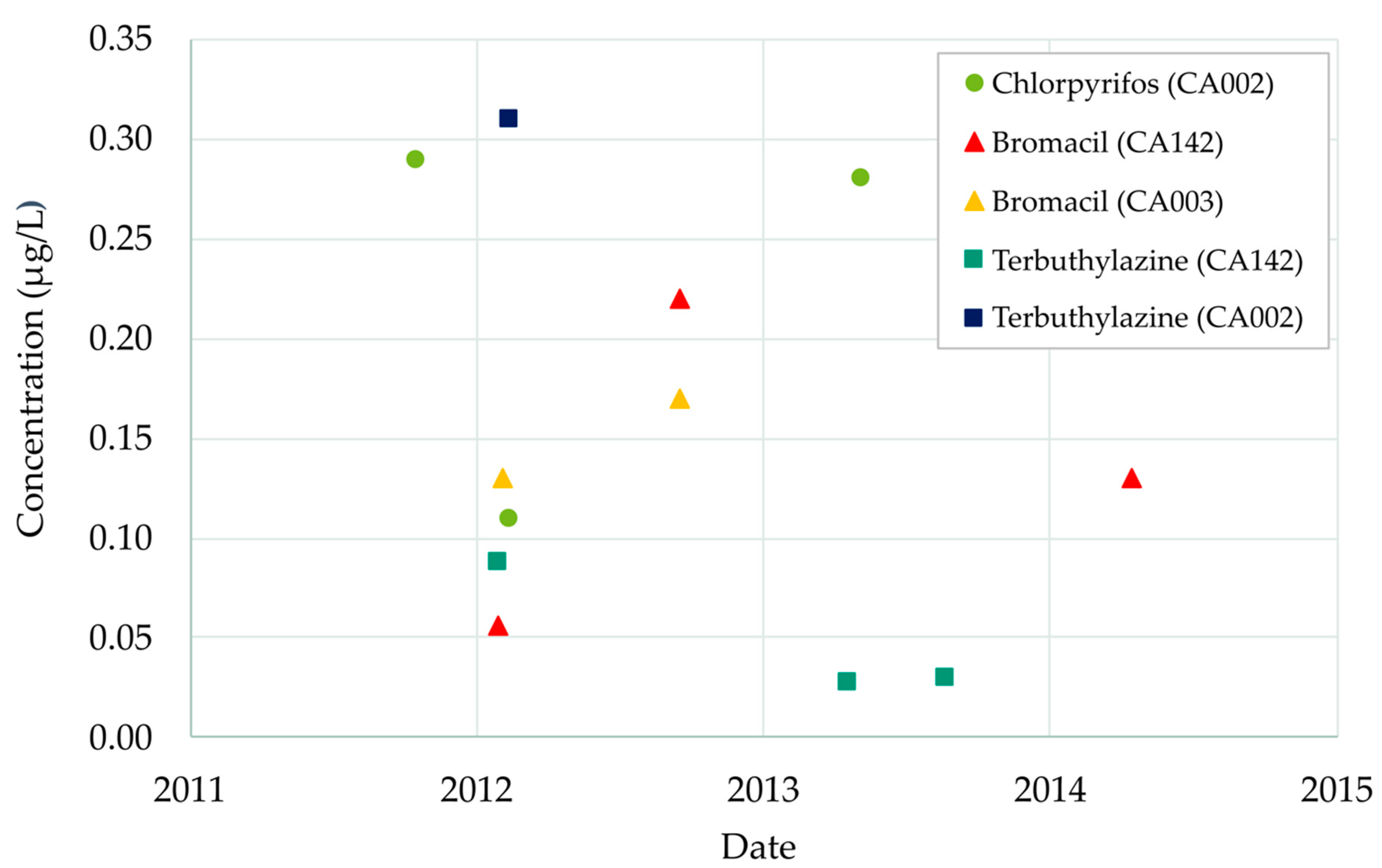
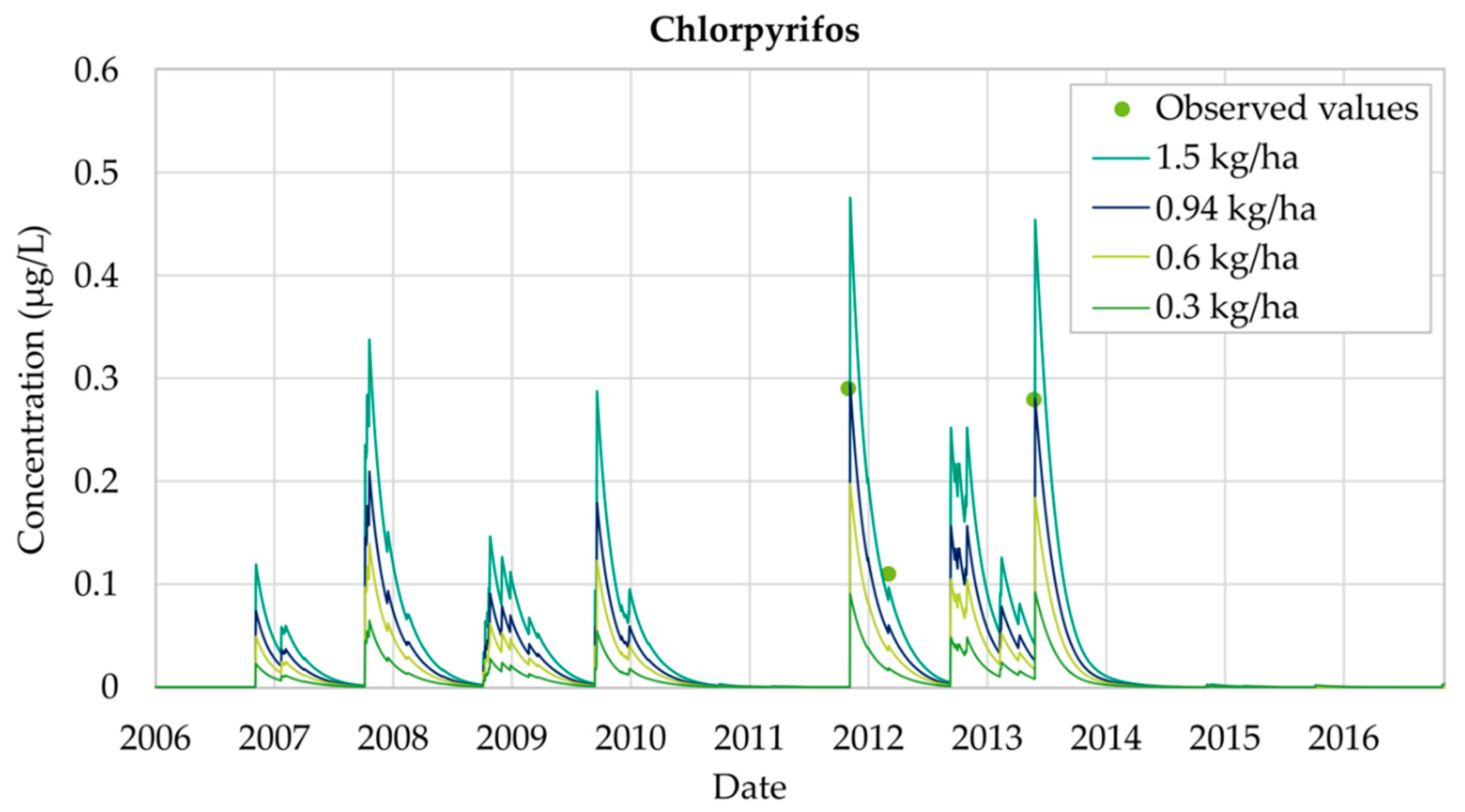

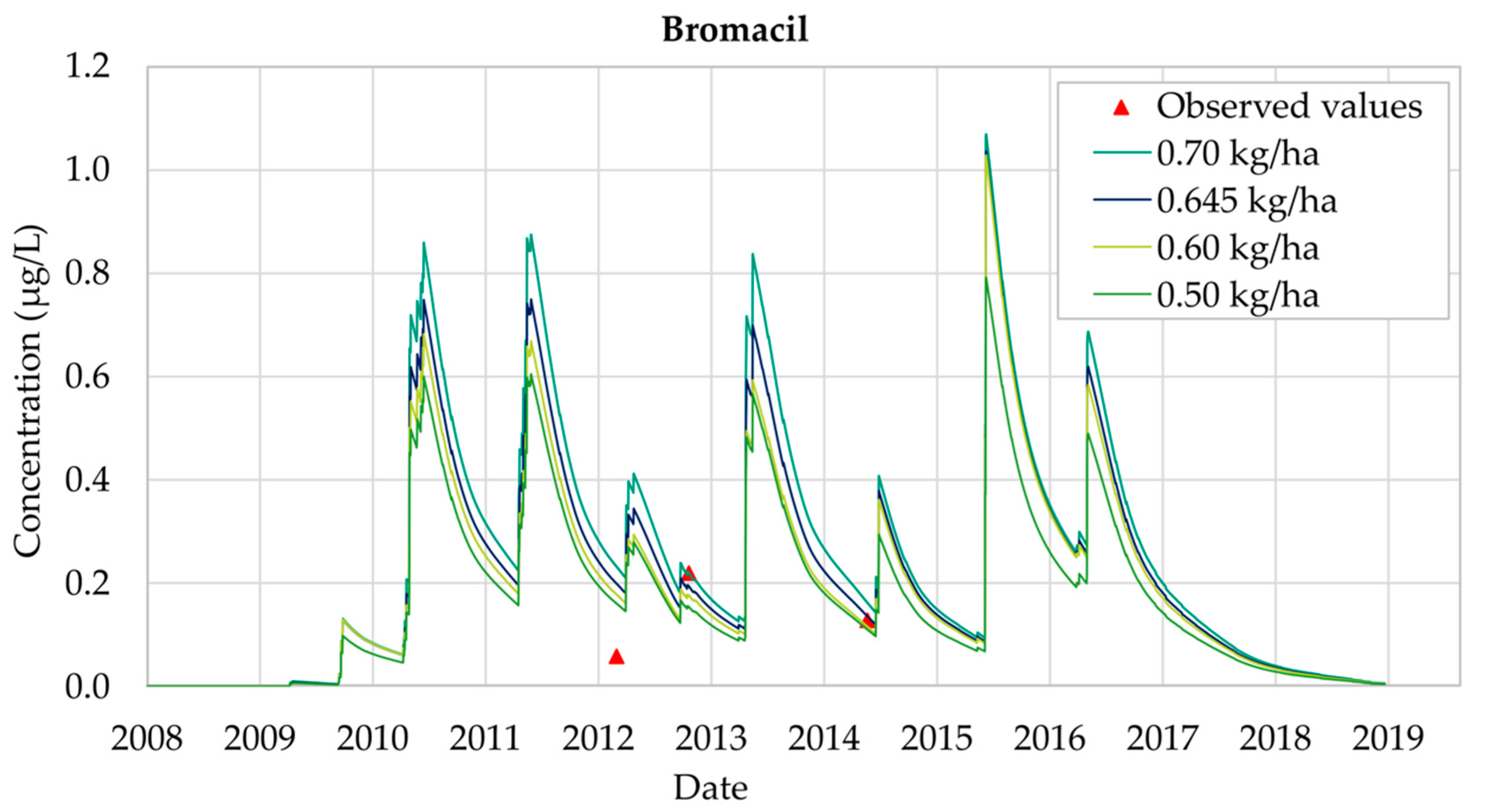

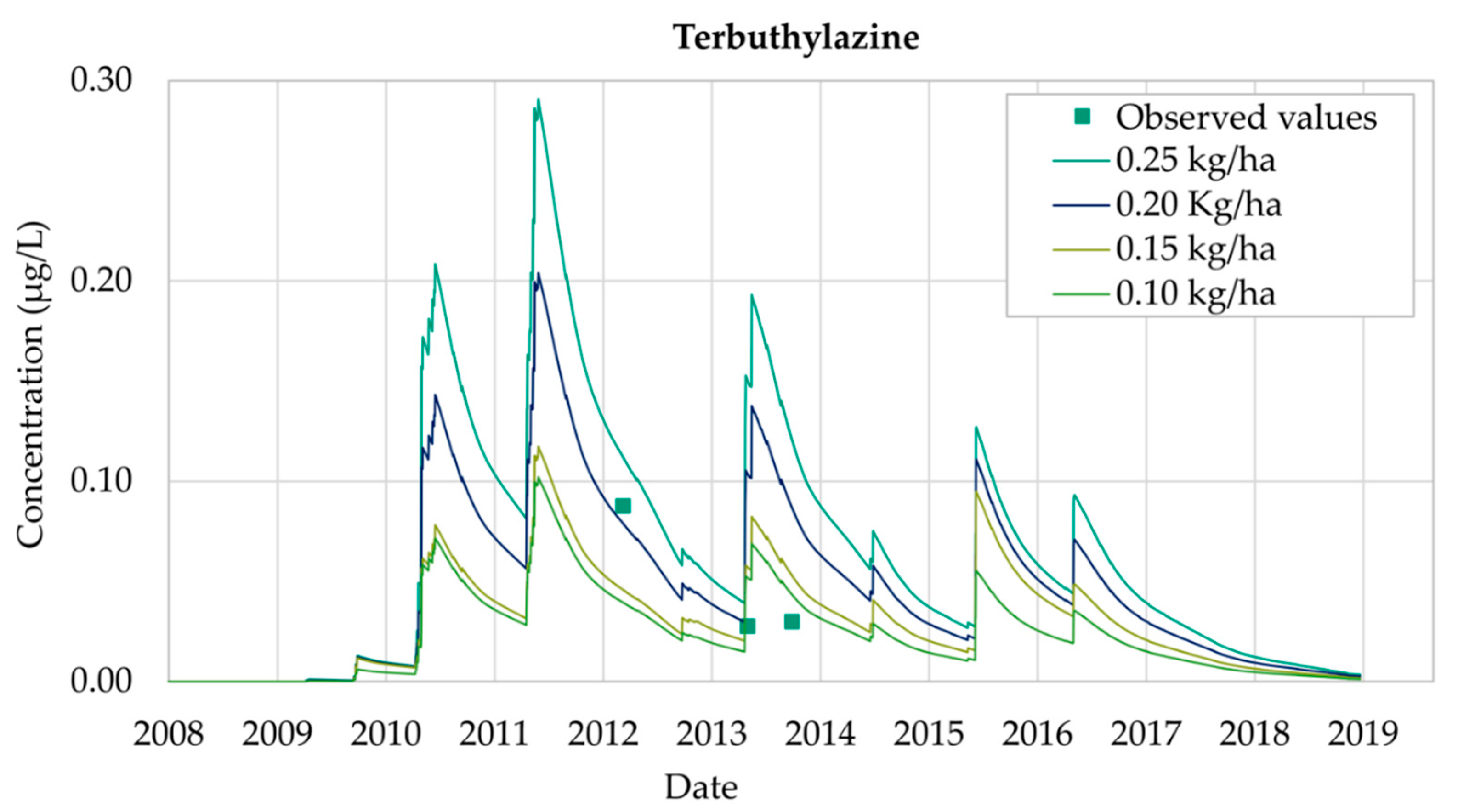
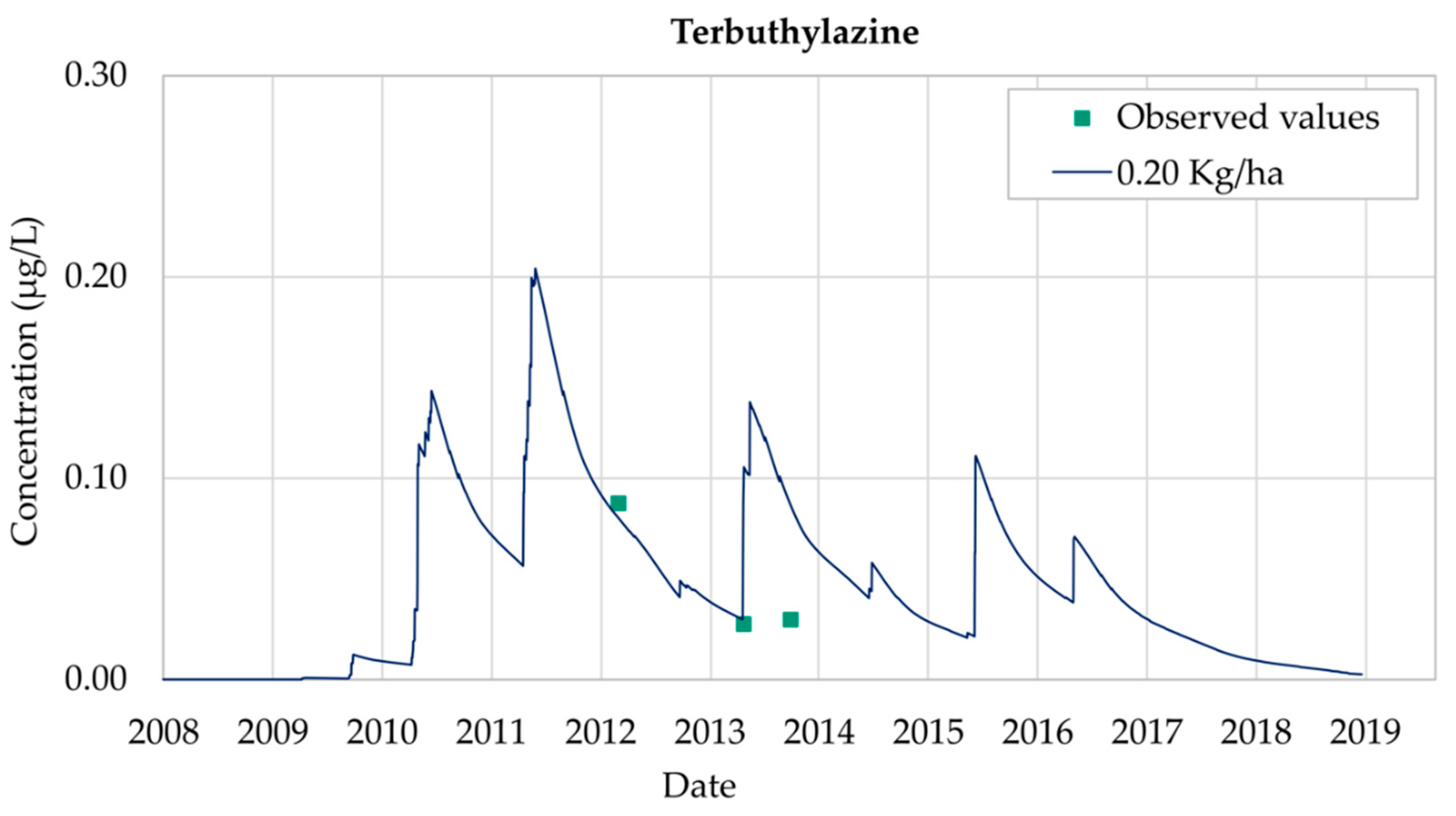
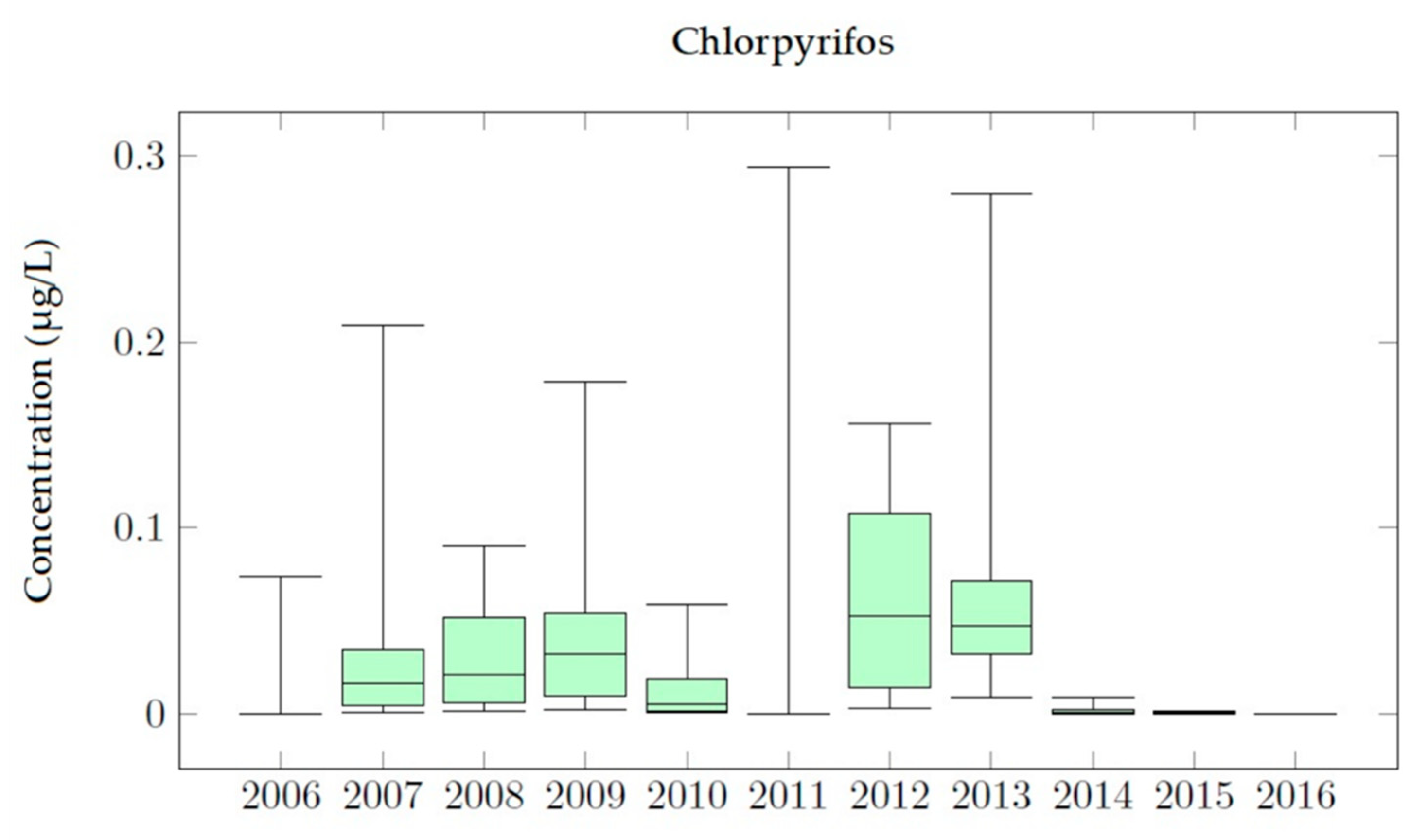

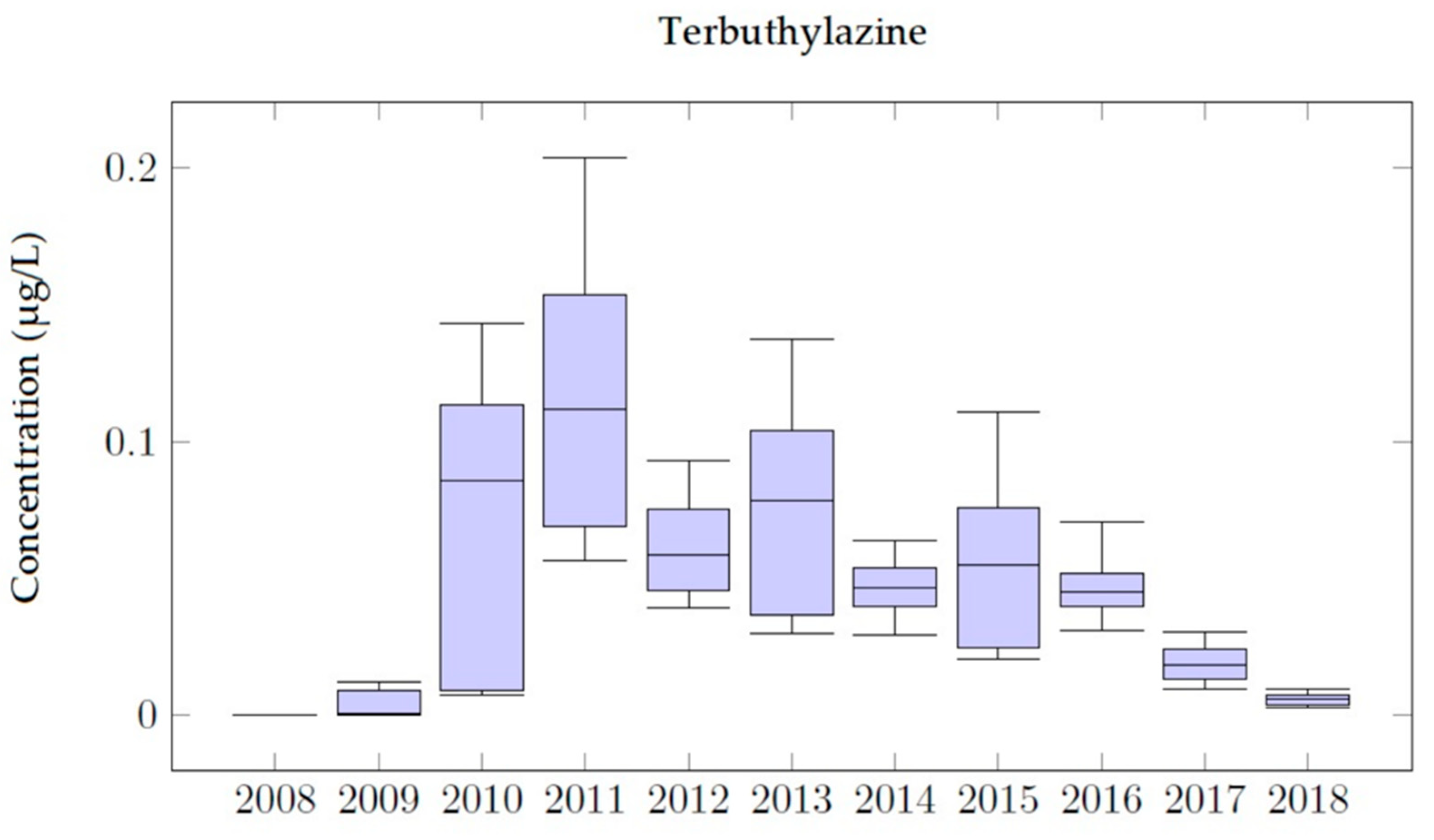
| Model | Ref. | Objectives | NSZ * | SZ ** | 1D–2D–3D | Processes |
|---|---|---|---|---|---|---|
| PESTAN | [13] | Pesticide concentration in soil | yes | no | 1D | Advection, dispersion and reactions |
| PRZM5 | [26] | Pesticide concentration in soil and groundwater | yes | yes | 1D | Advection, dispersion, reactions and root interactions |
| SCI-GROW | [14] | Pesticide analysis | no | yes | Under development | |
| SUTRA | [15] | Heat and solute transport | yes | yes | 3D | Advection, diffusion and sorption |
| HYDRUS | [16] | Heat and solute transport | yes | yes | 3D | Advection, dispersion and reactions between phases |
| TOXSWA | [17] | Pesticide in aquatic ecosystems | yes | no | 2D | Transformation, sorption, volatilization, advection, dispersion and diffusion |
| PEARL | [18] | Pesticide leaching in groundwater, infiltration and persistence | yes | yes | 1D | Advection, dispersion, sorption, volatilization, transformation, evaporation and plant absorption |
| Parameter | Unit | Chlorpyrifos | Ref. | Bromacil | Ref. | Terbuthylazine | Ref. |
|---|---|---|---|---|---|---|---|
| Sorption Coefficient | ml/g | 18.15 | [38] | 230 | [39] | 250 | [40] |
| Hydrolysis Half Life | days | 25.5 | [38] | 10 | [39] | 11 | [40] |
| Surface Soil Half Life | days | 21 | [38] | 21 | [39] | 30 | [40] |
| Soil Reference Temperature | °C | 20 | [40] | 20 | [40] | 20 | [40] |
| Molecular Weight | g/mol | 350 | [37] | 261.12 | [37] | 229.71 | [37] |
| Vapor Pressure | torr | 0.00013 | [37] | 0.00013 | [37] | 0.15 | [37] |
| Solubility | mg/L | 2 | [37] | 700 | [37] | 8.5 | [37] |
| Henry’s Constant | -- | 0.000164 | [39] | 0.000000037 | [39] | 0.00405 | [39] |
| Air Diffusion Coefficient | cm2/day | 4300 | [39] | 4300 | [39] | 4300 | [39] |
| Henry’s Heat | J/mol | 83,860 | [39] | 83,860 | [39] | 83,860 | [39] |
| Name | Lithology | Thickness (m) | Age | Hydrogeological Condition |
|---|---|---|---|---|
| Buntsandstein | Sandstone and conglomerates | 170–300 | Lower Triassic | Low-K |
| Muschelkalk | Dolomites, limestones and marls | 85–130 | Middle Triassic | Medium-K |
| Keuper | Plasters and clays | 40–100 | Upper Triassic | Impermeable |
| Jurassic–Cretaceous | Limestones and dolomites | 1000–1200 | Jurassic–Cretaceous | Variable K |
| Lower Miocene | Conglomerates, sands and limestones | 200 | Lower Miocene | Variable K |
| Upper Miocene | Lake limestones | Upper Miocene | Aquifer | |
| Quaternary | Gravels, sands, silts and clays | Pleistocene–Holocene | High-K |
| Hydrogeological Section | Nature | Thickness (m) | Hydrostatic Conditions | Permeability |
|---|---|---|---|---|
| Yátova Quaternary | Carbonated detrital | Unconfined | ||
| Southern Miocene | Carbonated | 200–600 | Confined | |
| Rambla de Bugarra Plioquaternary | Carbonated detrital | Mixed | ||
| Godelleta Miocene | Carbonated | Unconfined | Medium-K | |
| Cheste Plioquaternary | Carbonated detrital | 90 (minimum) | Unconfined | |
| Buñol-Cheste Jurassic–Tertiary | Carbonated detrital | Mixed | High-K | |
| Chiva-Cheste Plioquaternary | Carbonated detrital | Mixed | ||
| Cañada Fría Jurassic | Carbonated detrital | Mixed | High-K | |
| Urrea-Pedrizos Miocene | Carbonated detrital | 78–267 | Unconfined | Karst |
| La Balsica Upper Cretaceous | Carbonated detrital | Mixed | ||
| Lomayma Jurassic | Carbonated detrital | Mixed | ||
| El Palmeral Upper Cretaceous | Carbonated detrital | 350 (minimum) | ||
| Serretilla Jurassic | Carbonated | 700 (maximum) | Mixed | Karst |
| Parameter | Unit | Chlorpyrifos | Bromacil | Terbuthylazine | |||
|---|---|---|---|---|---|---|---|
| Amount (total) | kg/ha | 0.94 | 0.635 | 0.20 | |||
| Application Method | – | Above Crop | Above Crop | Above Crop | |||
| Number of Applications | – | 5 | 3 | 2 | |||
| Date | kg/ha | Date | kg/ha | Date | kg/ha | ||
| 1 April 1 May 1 June 1 July 1 August | 0.40 0.15 0.03 0.26 0.10 | 1 April 1 May 1 June | 0.245 0.19 0.20 | 10 April 10 May | 0.10 0.10 | ||
| Hydrometeorological Station | ||||||
|---|---|---|---|---|---|---|
| Well | Pesticide | Precipitation cm/d | Temperature °C | Wind Velocity cm/d | Evaporation Factor cm/s | Solar Radiation La/d |
| 080.140.CA002 La Purisima | Chlorpyrifos | N0L0201 | N7E0901 | N7E0901 | Meyer’s formula | Solar radiation Atlas in Spain [45] |
| 08.140.CA142 Llano de Cuarte | Bromacil Terbuthylazine | N0O0401 | N7P1201 | N7P1201 | ||
| Parameter | Unit | Well 08.140.CA002 (La Purísima) | ||||||
|---|---|---|---|---|---|---|---|---|
| Layer | 1 | 2 | 3 | 4 | 5 | 6 | 7 | |
| Thickness | cm | 10 | 10 | 20 | 20 | 20 | 20 | 400 |
| Density | g/cm3 | 1.2 | 1.2 | 1.2 | 1.3 | 1.35 | 1.35 | 1.48 |
| Max. Cap. | - | 0.207 | 0.207 | 0.207 | 0.207 | 0.270 | 0.270 | 0.270 |
| Min. Cap. | - | 0.095 | 0.095 | 0.095 | 0.095 | 0.117 | 0.117 | 0.117 |
| Organic Carbon | % | 1.7 | 1.7 | 0.7 | 0.7 | 0.3 | 0.3 | 0.3 |
| Nitrogen | - | 1 | 1 | 1 | 1 | 1 | 1 | 1 |
| Sand | % | 48 | 48 | 58 | 53 | 40 | 40 | 40 |
| Clay | % | 16 | 16 | 16 | 16 | 28 | 28 | 28 |
| Parameter | Unit | Well 08.140.CA142 (Llano de Cuarte) | ||||||
|---|---|---|---|---|---|---|---|---|
| Layer | 1 | 2 | 3 | 4 | 5 | 6 | 7 | |
| Thickness | cm | 10 | 10 | 20 | 20 | 20 | 20 | 500 |
| Density | g/cm3 | 1.3 | 1.25 | 1.25 | 1.25 | 1.25 | 1.25 | 1.49 |
| Max. Cap. | - | 0.318 | 0.339 | 0.339 | 0.339 | 0.339 | 0.339 | 0.207 |
| Min. Cap. | - | 0.197 | 0.239 | 0.239 | 0.239 | 0.239 | 0.239 | 0.095 |
| Organic Carbon | % | 0.26 | 0.12 | 0.12 | 0.12 | 0.12 | 0.12 | 0.71 |
| Nitrogen | - | 10 | 1 | 1 | 1 | 1 | 1 | 10 |
| Sand | % | 40 | 35 | 35 | 35 | 35 | 35 | 80 |
| Clay | % | 60 | 65 | 65 | 65 | 65 | 65 | 20 |
| Parameter | Unit | Value | Source |
|---|---|---|---|
| Root depth | cm | 50 | Survey |
| Canopy cover | % | 80 | Survey |
| Canopy height | cm | 200 | Survey |
| Canopy holdup | cm | 0.15 | Survey |
| Chlorpyrifos | ||||
| Application Dose | 0.3 kg/ha | 0.6 kg/ha | 0.94 kg/ha | 1.5 kg/ha |
| Peak concentration (μg/L) | 0.0920 | 0.1976 | 0.2946 | 0.4750 |
| Average concentration (μg/L) | 0.0081 | 0.0173 | 0.0258 | 0.0415 |
| Days > 0.10 μg/L | 0 | 124 | 301 | 538 |
| C = 0 date | 30 November 2013 | 13 January 2014 | 11 February 2014 | 18 March 2014 |
| Duration (days) | 2580 | 2624 | 2653 | 2688 |
| Bromacil | ||||
| Application dose | 0.50kg/ha | 0.60 kg/ha | 0.645 kg/ha | 0.70 kg/ha |
| Peak concentration (μg/L) | 0.7920 | 1.0289 | 1.0365 | 1.0696 |
| Average concentration (μg/L) | 0.1720 | 0.1995 | 0.2169 | 0.2442 |
| Days > 0.10 μg/L | 2342 | 2573 | 2598 | 2656 |
| C = 0 date | 10 June 2018 | 24 July 2018 | 6 August 2018 | 28 August 2018 |
| Duration (days) | 3347 | 3391 | 3404 | 3426 |
| Terbuthylazine | ||||
| Application dose | 0.10 kg/ha | 0.15 kg/ha | 0.20 kg/ha | 0.25 kg/ha |
| Peak concentration (μg/L) | 0.1020 | 0.1173 | 0.2093 | 0.2905 |
| Average concentration (μg/L) | 0.0229 | 0.0292 | 0.0458 | 0.0625 |
| Days > 0.10 μg/L | 8 | 58 | 512 | 907 |
| C = 0 date | 20 December 2017 | 16 April 2018 | 15 August 2018 | 18 October 2018 |
| Duration (days) | 3010 | 3127 | 3248 | 3312 |
Publisher’s Note: MDPI stays neutral with regard to jurisdictional claims in published maps and institutional affiliations. |
© 2021 by the authors. Licensee MDPI, Basel, Switzerland. This article is an open access article distributed under the terms and conditions of the Creative Commons Attribution (CC BY) license (http://creativecommons.org/licenses/by/4.0/).
Share and Cite
Pérez-Indoval, R.; Rodrigo-Ilarri, J.; Cassiraga, E.; Rodrigo-Clavero, M.-E. Numerical Modeling of Groundwater Pollution by Chlorpyrifos, Bromacil and Terbuthylazine. Application to the Buñol-Cheste Aquifer (Spain). Int. J. Environ. Res. Public Health 2021, 18, 3511. https://doi.org/10.3390/ijerph18073511
Pérez-Indoval R, Rodrigo-Ilarri J, Cassiraga E, Rodrigo-Clavero M-E. Numerical Modeling of Groundwater Pollution by Chlorpyrifos, Bromacil and Terbuthylazine. Application to the Buñol-Cheste Aquifer (Spain). International Journal of Environmental Research and Public Health. 2021; 18(7):3511. https://doi.org/10.3390/ijerph18073511
Chicago/Turabian StylePérez-Indoval, Ricardo, Javier Rodrigo-Ilarri, Eduardo Cassiraga, and María-Elena Rodrigo-Clavero. 2021. "Numerical Modeling of Groundwater Pollution by Chlorpyrifos, Bromacil and Terbuthylazine. Application to the Buñol-Cheste Aquifer (Spain)" International Journal of Environmental Research and Public Health 18, no. 7: 3511. https://doi.org/10.3390/ijerph18073511






